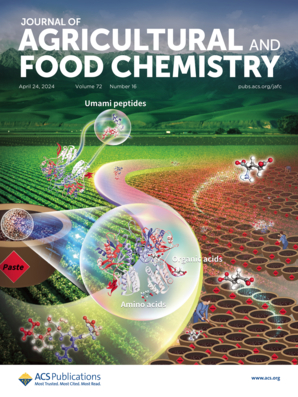通过ROS-NF-κB-NLRP3信号轴研究T-2毒素诱导胸腺上皮细胞损伤和免疫毒性的机制
IF 5.7
1区 农林科学
Q1 AGRICULTURE, MULTIDISCIPLINARY
引用次数: 0
摘要
胸腺上皮细胞(TECs)对胸腺结构和功能至关重要,但T-2毒素(T-2)对TECs及其相关分子通路的影响尚不清楚。本研究揭示了t -2诱导TEC损伤的机制,重点关注ROS-NF-κB-NLRP3信号轴。体内和体外分析表明,T-2通过ros驱动的NLRP3炎性体激活、NF-κB信号传导、炎症和细胞凋亡诱导TEC损伤。分子对接分析证实了T-2与氧化应激、炎症信号通路和细胞凋亡等关键成分的结合。针对ROS和NLRP3的治疗干预进一步支持了这些发现。n -乙酰半胱氨酸(NAC)可有效降低ROS水平,抑制NF-κB信号传导,抑制NLRP3激活,减轻炎症和细胞凋亡,这些作用与NLRP3抑制剂MCC950相对应,强调了ROS通过NF-κB信号传导介导的NLRP3炎性体激活在t -2诱导的TEC损伤中的关键作用。同时,NF-κB信号的抑制进一步抑制了MTEC1细胞的ROS水平、NLRP3炎性体激活和凋亡,强调了ROS-NF-κB-NLRP3轴在t -2诱导胸腺损伤发病机制中的关键作用。我们的研究为t -2诱导免疫毒性的机制提供了深入的见解,并确定了针对这些途径的潜在治疗策略,以减轻胸腺损伤和保持免疫功能。本文章由计算机程序翻译,如有差异,请以英文原文为准。
Mechanistic Insights into T-2 Toxin-Induced Thymic Epithelial Cell Injury and Immunotoxicity via the ROS-NF-κB-NLRP3 Signaling Axis.
Thymic epithelial cells (TECs) are critical for thymic structure and function, yet the impact of T-2 toxin (T-2) on TECs and related molecular pathways remains unclear. This study sheds light on the mechanisms of T-2-induced TEC damage, focusing on the ROS-NF-κB-NLRP3 signaling axis. The in vivo and in vitro analyses suggest that T-2 induces TEC injury through ROS-driven NLRP3 inflammasome activation, NF-κB signaling, inflammation, and apoptosis. Molecular docking analysis verified the binding of T-2 to critical components involved in oxidative stress, inflammatory signaling pathways, and apoptosis. These findings were further supported by therapeutic interventions targeting ROS and NLRP3. N-acetylcysteine (NAC) effectively reduced ROS levels, suppressed NF-κB signaling, inhibited NLRP3 activation, and mitigated inflammation and apoptosis, effects mirrored by the NLRP3 inhibitor MCC950, emphasizing the critical role of ROS-mediated NLRP3 inflammasome activation through NF-κB signaling in T-2-induced TEC damage. Concurrently, inhibition of the NF-κB signaling further suppressed ROS levels, NLRP3 inflammasome activation, and apoptosis in MTEC1 cells, emphasizing the pivotal function of the ROS-NF-κB-NLRP3 axis in the pathogenesis of T-2-induced thymic injury. Our study offers an in-depth insight into the mechanisms driving T-2-induced immunotoxicity and identifies potential therapeutic strategies targeting these pathways to mitigate thymic injury and preserve immune function.
求助全文
通过发布文献求助,成功后即可免费获取论文全文。
去求助
来源期刊
CiteScore
9.90
自引率
8.20%
发文量
1375
审稿时长
2.3 months
期刊介绍:
The Journal of Agricultural and Food Chemistry publishes high-quality, cutting edge original research representing complete studies and research advances dealing with the chemistry and biochemistry of agriculture and food. The Journal also encourages papers with chemistry and/or biochemistry as a major component combined with biological/sensory/nutritional/toxicological evaluation related to agriculture and/or food.

 求助内容:
求助内容: 应助结果提醒方式:
应助结果提醒方式:


